Genealogy Workshop - June 13
|
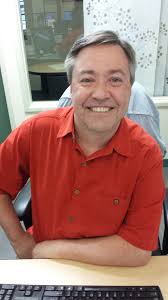 Do you get off the Internet and actually do genealogy research at a Library or Archives? Did you know you can? If you do, do you walk in the door dazed and confused? Getting lost and don’t know where to begin? Do you get off the Internet and actually do genealogy research at a Library or Archives? Did you know you can? If you do, do you walk in the door dazed and confused? Getting lost and don’t know where to begin?
Robert M. Wilbanks lV, our chief genealogist, will be the presenter at the June Gathering -Thursday June 13 - at the Irish Cultural Center, 1106 N Central, Phoenix.
His talk, aptly enough, is entitled ‘Understanding Research Facilities: Genealogy Research Anywhere’. Not every historical record is on the Internet. His presentation includes the various types of repositories and research facilities that are beneficial to Genealogists, including how they store, organization and make resources available to researchers. This presentation will empower you to do better and more efficient and effective Genealogy research almost anywhere.
Robert will be using a live screen with a PowerPoint and live access to the internet, so feel free to bring along your own wi-fi device to help you explore your family background. He also has prepared a handout for the presentation, which you can download.
6.30 - Social Half Hour (Bar opens)
7:00 -Genealogy Workshop
8:30 -Raffle and Adjourn
Society meetings are open to everyone. Members are free, and non-members are welcome at a charge o $10.00
|
Back to top  |
President's Letter
Don Finch, Past President
President David McBee asked if I could provide another update on openings for volunteering with the Society.
When the 55th Annual Games came to a close, we began looking to replace several key positions that had been staffed by long-time Area Chairs who would like some time off.
- Athletic Director – We are pleased to announce that Tim Timm will be the Athletic Director for 2020. Tim is an athlete himself and also runs the Rio Salado Scottish Heavy Athletics group. Thanks go to Michele Crownhart for her many years in this position.
- Clans Chair – Mark Pelletier is stepping down after 12 years of running the Clans Area, but will assist his replacement with the 2020 planning process
- Pipe Band Chair – Since Alasdair Martin has accepted a job transfer to the east coast a new Chair is needed. Being an active or recently retired member of a Pipe & Drum band is a prerequisite.
The Society is also looking to fill the following positions:
- Treasurer – We’re actively looking for a volunteer that has accounting or book-keeping experience, and is familiar with ‘QuickBooks for Nonprofits’.
- Social Committee Chair(s) – the perfect job for two people to work as co-chairs on our regular Gatherings, and special events such as the Burns Supper, and Tartan Day
For all these open positions - please contact David McBee if you, or someone you know is interested: president@arizona.scot
Cheers!
Don |
Back to top  |
The Long Walk - Camino de Santiago
Len Wood
Pipe Major Len Wood, a long-time CSA member and the man who launched the Phoenix Scottish Games 55 years ago, recently embarked on a 200-mile pilgrimage in Spain with Henry Frantz, a fellow piper he has known since the 1970s. The walk took two weeks and was at times gruelling, but for the two men there was a special poignancy involved. Here Len describes the experience.
Flying from Atlanta to Madrid reminded me of the adage “Flying on a wing and a prayer.” We were flying to Spain to follow in the footsteps of hundreds of thousands of pilgrims before us to walk the Camino de Santiago.
Camino de Santiago refers to routes leading to Santiago de Compostela (St James of the Field of Stars), the patron saint of Spain. The remains of what are believed to be of the saint are in a silver container in the Cathedral of Santiago, the end point for most pilgrims. The first of these were known to have walked there around 950AD. This really is a test of your endurance, especially if you are from the flat lands of the Phoenix area. Even a hike up the hills surrounding our valley does not prepare you for the long and somewhat steep hills in Galicia. My knees will attest to that.
 Henry and I have been friends since the early 70s when I was stationed on a US Navy ship in Charleston, SC. Henry and I have been friends since the early 70s when I was stationed on a US Navy ship in Charleston, SC.
When his daughter Beca was born I was asked to be her Godfather and two years ago when she was married, I piped Beca and husband James out of the church.
When my wife Kathy was in hospice care, Henry flew out from Atlanta and was here when she died.
When his wife Fran passed away last March, I visited with Henry and learned of their plan to walk the Camino this year.
I volunteered to accompany him on the journey.
We flew to Madrid on March 11, then took the train to Leon, where we started our pilgrimage, a 200-mile walk to Santiago.
Our trip took us through hills and valleys of breathtaking beauty. We used a service that picked up our bags in the morning and delivered them to pre-arranged hotels. This then set up our course of travel; our first day was 20 miles and days after that varied from five to 17 miles each day. The route is very well marked with yellow scallop shells and arrows painted on posts, walks and buildings. The scallop shell is also a symbol for pilgrims to wear around the neck or on your backpack.
You can travel any time and we decided that March, while the weather might be iffy, would find fewer pilgrims and avoid the hot summer months. We were lucky as this year’s weather was warm and dry. John Brierly’s guide book talked about trudging through lashing rain in Galicia. I can’t imagine what that must have been like when walking over hills of cobblestones and mud. This weather was definitely a gift. The end goal of the trip is to attend the Pilgrim’s Mass at the Cathedral de Santiago. Unfortunately, the church is going through a major repair, with scaffolding everywhere.
 The mass was been moved to the Church of St. Francis of Assisi, also a very beautiful building. In addition, you can receive a “Compostela” or certificate in Latin attesting that you completed a minimum of 100kms on your pilgrimage. As proof the pilgrim gets a passport at the start that must be stamped and dated no less than twice per day leading up to the final day in Santiago. The clerk even writes you name “Leonardum Wood” in Latin on your Compostela. The mass was been moved to the Church of St. Francis of Assisi, also a very beautiful building. In addition, you can receive a “Compostela” or certificate in Latin attesting that you completed a minimum of 100kms on your pilgrimage. As proof the pilgrim gets a passport at the start that must be stamped and dated no less than twice per day leading up to the final day in Santiago. The clerk even writes you name “Leonardum Wood” in Latin on your Compostela.
The long walk gives one plenty of time for contemplation and prayer, and to share experiences with fellow pilgrims. I met a father and son team from Louisiana who started in St. Jean and were finishing up a 45-day trip.
My pilgrimage was three weeks from start to finish (fourteen days to walk the 200 miles.) |
|
Meet Our Members - Doug Hall
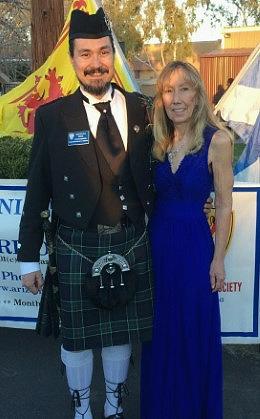 Douglas Hall is one of the CSA’s most enthusiastic members. He owns four kilts, three sporrans, and is even learning how to play the bagpipes and speak Gaelic. Douglas Hall is one of the CSA’s most enthusiastic members. He owns four kilts, three sporrans, and is even learning how to play the bagpipes and speak Gaelic.
What is remarkable is that he has known about his Scottish identity for only two years. And the story of how he came to discover his Scottishness is fascinating.
Doug was born in 1964 on the outskirts of Seoul, South Korea, to a Korean woman and a US serviceman.
He moved from foster home to foster home until, at the age of four, he was adopted by an American couple named Richard and Christine Hall.
Until then, his name had been Bobby Park – all “unknown” children in Korea take on the name of the Korean president, which at that time was Park Chung-hee.
His adoptive parents gave him the name Douglas Hall and he kept the middle name Park. “It was a good Scottish name, I lucked out there,” he said.
Doug grew up around Colorado Springs. “I wasn’t used to sleeping on beds, and I kept rolling out of bed and laying on a mat on the floor, like they do in the Orient. And I was so fascinated by the lights at my first Christmas that I remember sleeping under the tree. I came from not much of anything. but they treated me well’”.
However, he was often introduced as the couple’s adoptive son and found it frustrating that he did not really known his identity.
In 1983 Doug left school and joined the Air Force, His first posting was to RAF Lakenheath in England, and he spent eight years in the UK, the highlight of which was a single trip to Scotland. He recalls, “Everyone else spent their time in bars and pubs, I spent my time going on tours visiting castles. I had a deep love of history. I made one trip to Scotland and that was the highlight of my whole career. Unbeknown to me, I didn’t realize I was visiting my homeland.
“I got posted up in Edinburgh, that was near the base for the jet, and I got to go and see the town. They were the most friendly people in the world, they were just wonderful people. We got to go to a few pubs in the city and I was surprised by the friendliness…people would buy us drinks."
“One day we helped the Scottish crew of a Harrier jet repair the aircraft. Afterwards the pilot took off in vertical fashion and we all stood to attention and saluted and watched him take off. The coolest thing was he turned back in jet mode and basically strafed us, super low. We heard the boom, a thrill and a half. That was my only ever visit to Scotland.”
In 2014 Doug’s wife Becky traced her own family history back many generations and decided to try to find his real family. At Christmas of 2015 she got a DNA kit and started working on it. It took a year and a half of research but eventually she discovered a second cousin who had put her DNA on.
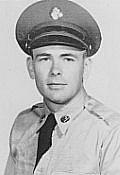 It was the Eureka moment Doug had been waiting for all his life. His cousin’s grandfather and Doug’s father were siblings. The father’s name was unquestionably Scottish, Donald Edgar Kilpatrick. It was the Eureka moment Doug had been waiting for all his life. His cousin’s grandfather and Doug’s father were siblings. The father’s name was unquestionably Scottish, Donald Edgar Kilpatrick.
He had been in the Army and was both a Vietnam and Korean War veteran. He originally came from Michigan, and most of his family have stayed around Lansing. Sadly, he passed away in 2003 but Doug was able to visit and meet his half-sister.
Doug’s family are Kilpatricks (or Kirkpatricks) with their heritage in Scotland.
“I was ever so proud about it. Before that I almost separated from humans in that I didn’t know where I came from. I now had an identity and I went full bore. I now have four kilts and three sporrans. I’m going to Scotland as soon as possible, we’re saving up, almost there.”
“I love the Caledonian Society and I’ve joined SAMS, the Scottish American Military Society, I didn’t think this would ever have been possible, but I think ancestry is so important, especially to give you a grounded belonging to where you came from.”
|
|
|
Scotland's Hidden Gems - on the trail of Macbeth
Iain Lundy
If you want to embark on a literary tour when you visit Scotland, there are plenty of options. Robert Burns and Robert Louis Stevenson are the obvious choices, but Scotland was also the homeland of Sherlock Holmes creator Sir Arthur Conan Doyle; Peter Pan author J M Barrie; and the great 19th century playwright Sir Walter Scott.
But did you know that lovers of the English literary giant William Shakespeare can find a little bit of Scotland devoted to their hero? The Shakespeare play Macbeth was of course set in Scotland and followed the fortunes of the villainous title character. It was based – very loosely – on the life of a real life 11th century Scottish king of the same name.
It is entirely possible to plan a Macbeth tour when visiting Scotland. One place that must be on the itinerary is the remote Aberdeenshire village of Lumphanan. It is there that the real Macbeth was killed in his final battle.
 The village attracts large numbers of Macbeth aficionados every year and there are three sites in particular that are worth a visit. The village attracts large numbers of Macbeth aficionados every year and there are three sites in particular that are worth a visit.
At Burnside he enjoyed a drink before the battle; closer to the village is Macbeth’s Stone where he is said to have been beheaded after his defeat; and at Perk Hill is Macbeth’s Cairn, supposedly the suite of his burial.
Lumphanan itself is a peaceful little place on Royal Deeside, close to the larger towns of Banchory and Aboyne. It is still an area given over to farming and the peace and quiet seems far removed from the violence and death associated with Macbeth’s last battle.
Other parts of Scotland that should be on any Macbeth tour include Dingwall, where he is believed to have been born; Cawdor Castle and Glamis Castle (he held the title Thane of Cawdor and Thane of Glamis); Brodie Castle where the three witches met; Birnam Woods and Dunsinane Hill in Perthshire, where Macbeth was killed in the play by Macduff; Moot Hill at Scone, where he was crowned; and Iona Abbey, his final resting place.
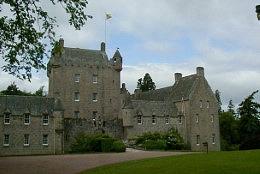

Cawdor Castle Glamis Castle
Back to top  |
Research Your Scottish Ancestry
|
|
 Newspapers: News of our Ancestors Newspapers: News of our Ancestors
by Robert M. Wilbanks IV, B.A.
Chief Genealogist & Historian, C.S.A.
genealogy@arizonascots.com
A little known, but no less important, genealogical resource is newspapers. Whether they are mentioned directly or indirectly, or not at all, newspapers can be the day-to-day (or week-to-week) story of our ancestors’ lives and the community they lived in.
They are written as events happen, making them an excellent source for family history research. They can be a great, and even fun, resource for genealogy.
Newspapers usually serve a geographical region, with national, state or local publications. They can also be ethnic based, such as Polish, German, or Irish or Scottish newspapers in America, and some are religious based, at the national or local level, whether Catholic, Methodist, Baptist, etc. And of course, they can be politically based, whether Whig, Liberal, Democratic, Republican, etc. So, a mention of your ancestors in any of these can indicate a character trait or viewpoint.
Newspapers began in the mid to late 1600s, and may have started out monthly or weekly. With technological advancements, the daily newspaper began to appear in the late 1700s. In America, Boston began one of the earliest newspapers, with weekly publications in New York and Philadelphia beginning by the early 1700s. In 1783, the Pennsylvania Evening Post became the first daily publication in America.
In Scotland, newspapers began in the mid-1600s, and became more established in the early 1700s. The Edinburgh Evening Courant (1718) and the Caledonian Mercury (1720) were the more significant early papers, though they were more national and international in scope, with little local news. Regional publications began with the Glasgow Journal (1741) and the Aberdeen Journal (1748). The Glasgow Mercury (1778) focused more on local news.
While the most common use of newspapers in genealogy is for the more obvious and direct publishing of birth and marriage announcements, and obituaries, there is so much more that can be found in these weekly or daily local publications. Newspapers have been found to regularly publish voter lists or school listings, ships’ passenger lists, various court, including estate and probate cases, and announcements of visitors to the homes of local residents. Church and social groups have stories written about events and activities, listing members in attendance. Business announcements are also published frequently, noting if your ancestor opened a shop, or announced a new service, set up a medical or law practice; or announcing the receipt of a shipment of goods, etc. Also, announcements of unclaimed mail were regular occurrences. And often, to the embarrassment of the local residents, newspapers frequently announced personal domestic issues and social indiscretions, such as runaway wives and drunken husbands, ailments, trips, unsavory visitors, killings, and much more.
One of the key significances of newspapers is that they often survived in local areas where records were otherwise lost or destroyed. Announcements of upcoming court cases were often required to be published in successive issues for three weeks or three months, seeking creditors or lost family, etc., before the cases were brought before the court. This is a great substitute where court records were lost or destroyed. Also, in jurisdictions where vital records were not kept, newspapers are a great place to find announcements of births, marriages and deaths. Sometimes certain local announcements would spread around a region in multiple newspapers. So, at a time or in an area where there are gaps in publications, the same announcement can be found copied in another publication across county lines.
Fortunately, due to our advanced technology, newspapers are extensively digitized and available on various websites for free or a fee. Ancestry, MyHeritage, FindMyPast, and many other genealogical subscription sites have numerous newspapers, including a wealth of British and Scottish publications. There are also fee-based sites that provide access to numerous newspapers from around the world, such as GenealogyBank, NewspaperArchive, and more. Chronicling America (chroniclingamerica.loc.gov), by the U.S. Library of Congress, has an extensive collection of digitized early American newspapers up to 1963. Usually, surname and keyword searches are available, with limiters by date, region, etc., making the search and the results more manageable.
Of course, like any other aspect of genealogy, the key is to know the right place and the right time to search newspapers. Additionally, you have to learn what newspapers were published at that time and in that place, and you have to learn what is now available and where it can be found today. But it is well worth the effort when you find the news and stories about your ancestors that you couldn’t find in other more standard records and resources.
This is another of a series of articles in which I show you the basics of searching for your family history, discussing the use of family records, public records, and online resources nationally and internationally, etc. The previous articles are now available on the Genealogy Section of this website. See “Genealogy” in the menu options at the top of the web page.
|
Pint and a Pour Event
Several CSA members are now the proud owners of bottles of apple pie liqueur and some rather exotic gins following our Pint and a Pour event last month at the Sleepy Dog Brewery and Caskwerks Distilling Company in Tempe.
The event was a great success, and like good Scots, we enjoyed the tasting sessions, the beer flights, and all the alcohol on offer. The staff at the premises on University Drive were exceptionally helpful in explaining the history and ethos of the company.
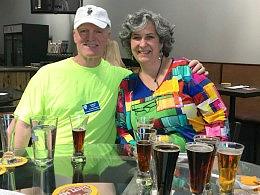
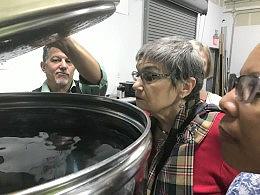
Lots to taste at the event Checking the brew batch
The 30 or so members who attended were shown around the distillery in two groups and many purchases of the uniquely flavored spirits were bought. Thanks to Ian Warrander for organizing the day out.
|
|
Peaks Celtic Ensemble Event
Hearing the song Caledonia being performed is always moving for anyone of Scottish heritage. The song formed part of a concert last month by the Peaks Celtic Ensemble and it was as emotional as ever.
The show was held at the Shepherd of the Hills Church on East Lafayette Boulevard and staged by the Welsh League of Arizona, and CSA members were there to help it go successfully.
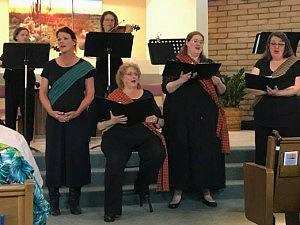 All proceeds went to fund the League’s bursary fund for Arizona-Welsh exchange students. All proceeds went to fund the League’s bursary fund for Arizona-Welsh exchange students.
The musical program by the Ensemble, who traveled from Flagstaff, proved a huge success and included favorites such as Mairi’s Wedding. |
|
Skerryvore Returns
Arizona is rapidly becoming the favorite overseas destination for acclaimed Scottish Celtic rock band Skerryvore. The group, which was formed in 2005 on the west coast island of Tiree, is returning to Phoenix for the third time in the past 12 months.

This time round, the band is playing at the Musical Instrument Museum (MIM) on June 27 at 4725 East Mayo Boulevard, Phoenix. The concert is at 7.30pm and ticket prices range from $33.50 to $43.50.
mim.org/events/skerryvore-jun-27-2019/ |
|
COMING EVENTS and Highland Games in Arizona and Nearby
|
|
|
Membership Reminder
Membership dues for 2019 are:
- - $30.00 single and $50.00 Family (at the same address)
It's easy - just jump to the Membership Page for information.
Society Gatherings
Membership gatherings are often held on the second
Thursday of each month, many at the Irish Cultural Center,
1106 N. Central Ave., Phoenix - others around the Valley - usually beginning at
6:30 pm. Please check our website for further details.
|
|
|